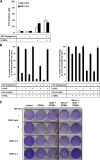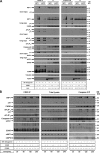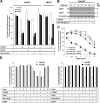Cellular IAPs inhibit a cryptic CD95-induced cell death by limiting RIP1 kinase recruitment
- PMID: 20038679
- PMCID: PMC2806279
- DOI: 10.1083/jcb.200904158
Cellular IAPs inhibit a cryptic CD95-induced cell death by limiting RIP1 kinase recruitment
Abstract
A role for cellular inhibitors of apoptosis (IAPs [cIAPs]) in preventing CD95 death has been suspected but not previously explained mechanistically. In this study, we find that the loss of cIAPs leads to a dramatic sensitization to CD95 ligand (CD95L) killing. Surprisingly, this form of cell death can only be blocked by a combination of RIP1 (receptor-interacting protein 1) kinase and caspase inhibitors. Consistently, we detect a large increase in RIP1 levels in the CD95 death-inducing signaling complex (DISC) and in a secondary cytoplasmic complex (complex II) in the presence of IAP antagonists and loss of RIP1-protected cells from CD95L/IAP antagonist-induced death. Cells resistant to CD95L/IAP antagonist treatment could be sensitized by short hairpin RNA-mediated knockdown of cellular FLICE-inhibitory protein (cFLIP). However, only cFLIP(L) and not cFLIP(S) interfered with RIP1 recruitment to the DISC and complex II and protected cells from death. These results demonstrate a fundamental role for RIP1 in CD95 signaling and provide support for a physiological role of caspase-independent death receptor-mediated cell death.
Figures









Similar articles
-
cIAPs block Ripoptosome formation, a RIP1/caspase-8 containing intracellular cell death complex differentially regulated by cFLIP isoforms.Mol Cell. 2011 Aug 5;43(3):449-63. doi: 10.1016/j.molcel.2011.06.011. Epub 2011 Jul 7. Mol Cell. 2011. PMID: 21737330 Free PMC article.
-
Cellular FLICE-inhibitory protein (cFLIP) isoforms block CD95- and TRAIL death receptor-induced gene induction irrespective of processing of caspase-8 or cFLIP in the death-inducing signaling complex.J Biol Chem. 2011 May 13;286(19):16631-46. doi: 10.1074/jbc.M110.148585. Epub 2011 Mar 22. J Biol Chem. 2011. PMID: 21454681 Free PMC article.
-
Membrane-bound Fas ligand requires RIP1 for efficient activation of caspase-8 within the death-inducing signaling complex.J Immunol. 2009 Sep 1;183(5):3278-84. doi: 10.4049/jimmunol.0803428. Epub 2009 Jul 29. J Immunol. 2009. PMID: 19641134 Free PMC article.
-
Regulation of CD95/Fas signaling at the DISC.Cell Death Differ. 2012 Jan;19(1):36-41. doi: 10.1038/cdd.2011.155. Epub 2011 Nov 11. Cell Death Differ. 2012. PMID: 22075988 Free PMC article. Review.
-
Characterization of the ripoptosome and its components: implications for anti-inflammatory and cancer therapy.Methods Enzymol. 2014;545:83-102. doi: 10.1016/B978-0-12-801430-1.00004-4. Methods Enzymol. 2014. PMID: 25065887 Review.
Cited by
-
IAPs, TNF, inflammation and Jürg Tschopp; a personal perspective.Cell Death Differ. 2012 Jan;19(1):1-4. doi: 10.1038/cdd.2011.166. Cell Death Differ. 2012. PMID: 22158430 Free PMC article. No abstract available.
-
Programmed Cell Death Pathways in Cholangiocarcinoma: Opportunities for Targeted Therapy.Cancers (Basel). 2023 Jul 15;15(14):3638. doi: 10.3390/cancers15143638. Cancers (Basel). 2023. PMID: 37509299 Free PMC article. Review.
-
CLL cells are resistant to smac mimetics because of an inability to form a ripoptosome complex.Cell Death Dis. 2013 Aug 29;4(8):e782. doi: 10.1038/cddis.2013.305. Cell Death Dis. 2013. PMID: 23990022 Free PMC article.
-
IAP proteins as targets for drug development in oncology.Onco Targets Ther. 2013 Sep 16;9:1285-304. doi: 10.2147/OTT.S33375. Onco Targets Ther. 2013. PMID: 24092992 Free PMC article. Review.
-
The Inhibitor of Apoptosis (IAPs) in Adaptive Response to Cellular Stress.Cells. 2012 Oct 10;1(4):711-37. doi: 10.3390/cells1040711. Cells. 2012. PMID: 24710527 Free PMC article.
References
-
- Bertrand M.J., Milutinovic S., Dickson K.M., Ho W.C., Boudreault A., Durkin J., Gillard J.W., Jaquith J.B., Morris S.J., Barker P.A. 2008. cIAP1 and cIAP2 facilitate cancer cell survival by functioning as E3 ligases that promote RIP1 ubiquitination. Mol. Cell. 30:689–700 10.1016/j.molcel.2008.05.014 - DOI - PubMed
-
- Blankenship J.W., Varfolomeev E., Goncharov T., Fedorova A.V., Kirkpatrick D.S., Izrael-Tomasevic A., Phu L., Arnott D., Aghajan M., Zobel K., et al. 2009. Ubiquitin binding modulates IAP antagonist-stimulated proteasomal degradation of c-IAP1 and c-IAP2(1). Biochem. J. 417:149–160 10.1042/BJ20081885 - DOI - PubMed
Publication types
MeSH terms
Substances
LinkOut - more resources
Full Text Sources
Research Materials
Miscellaneous

